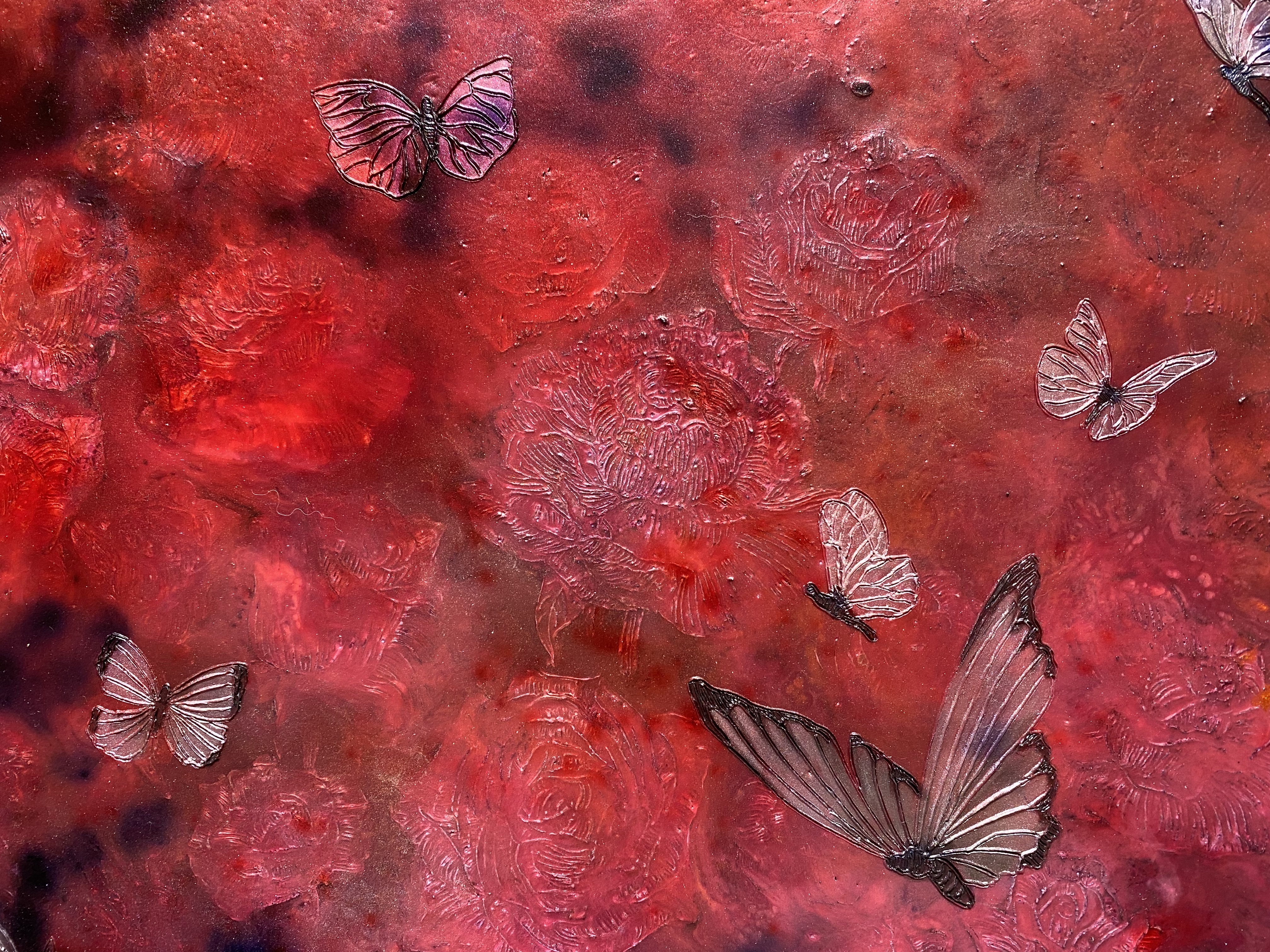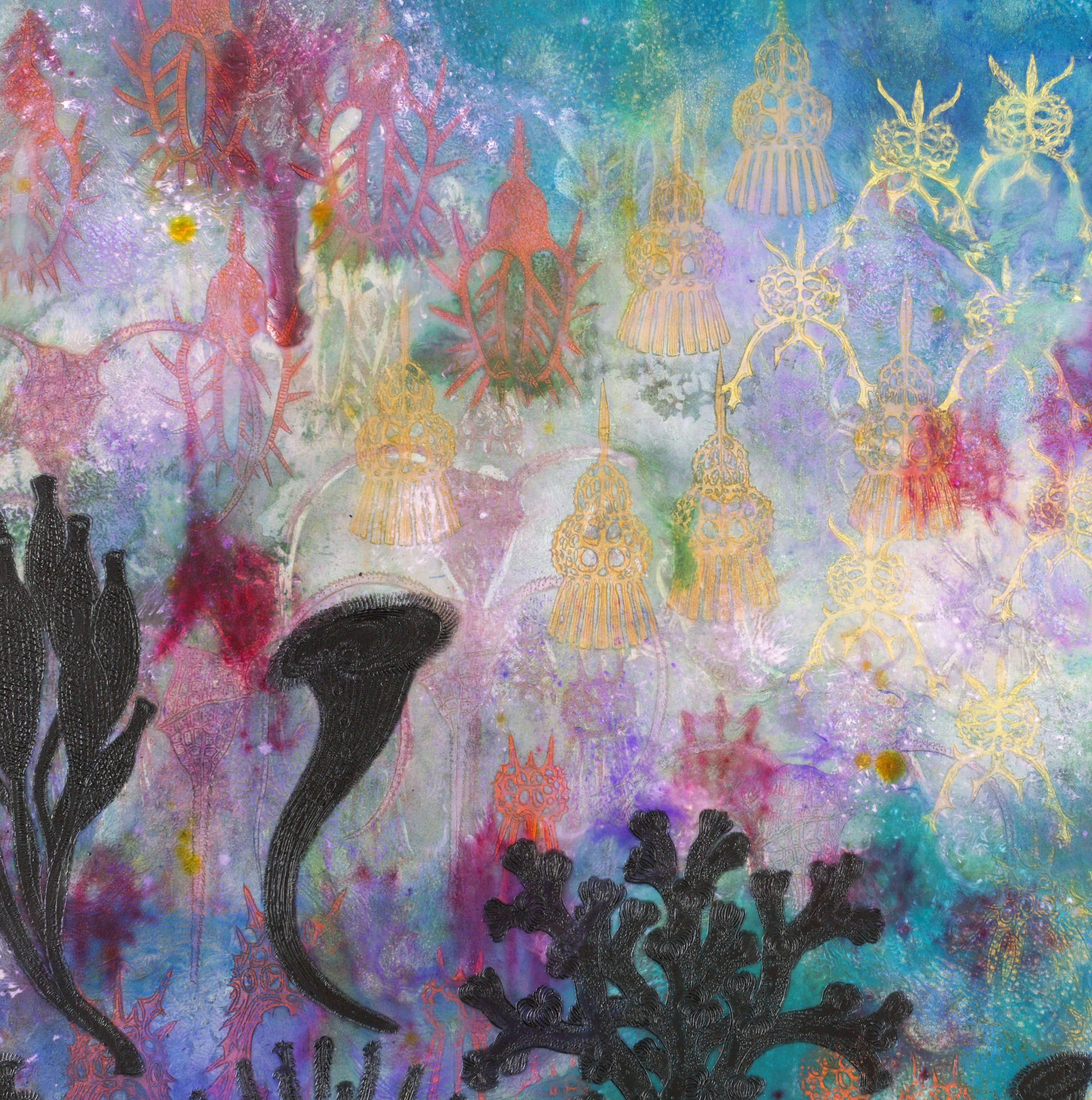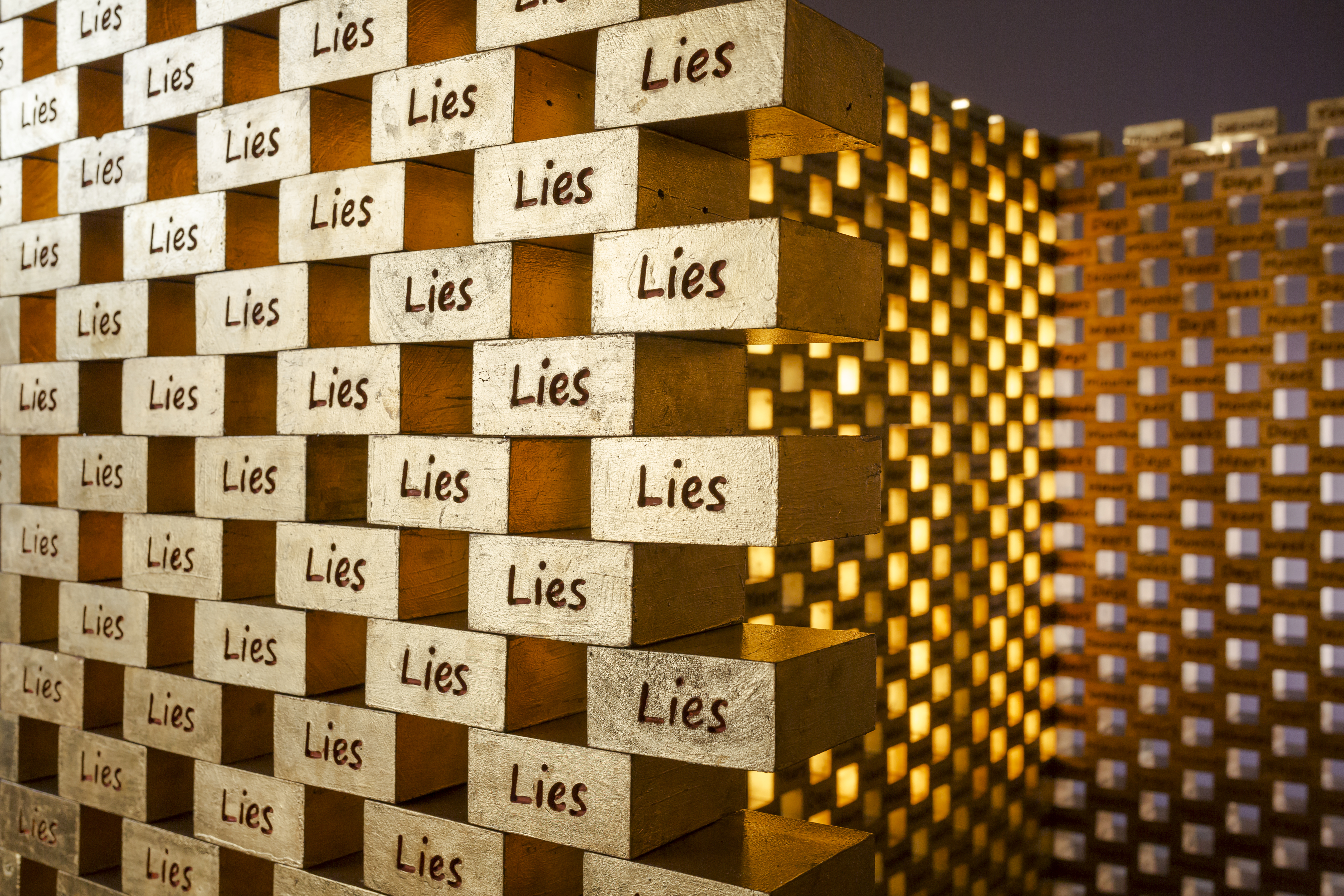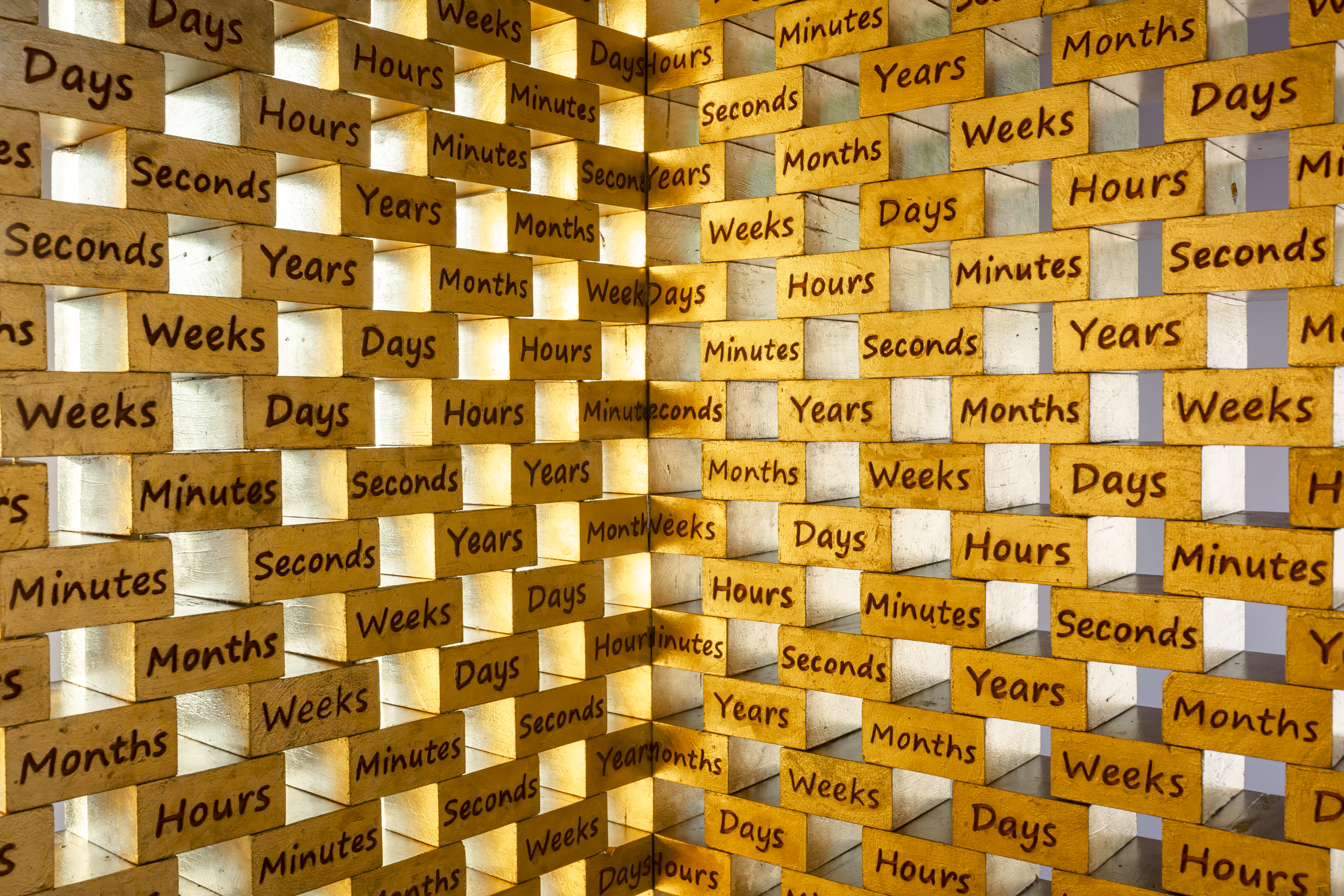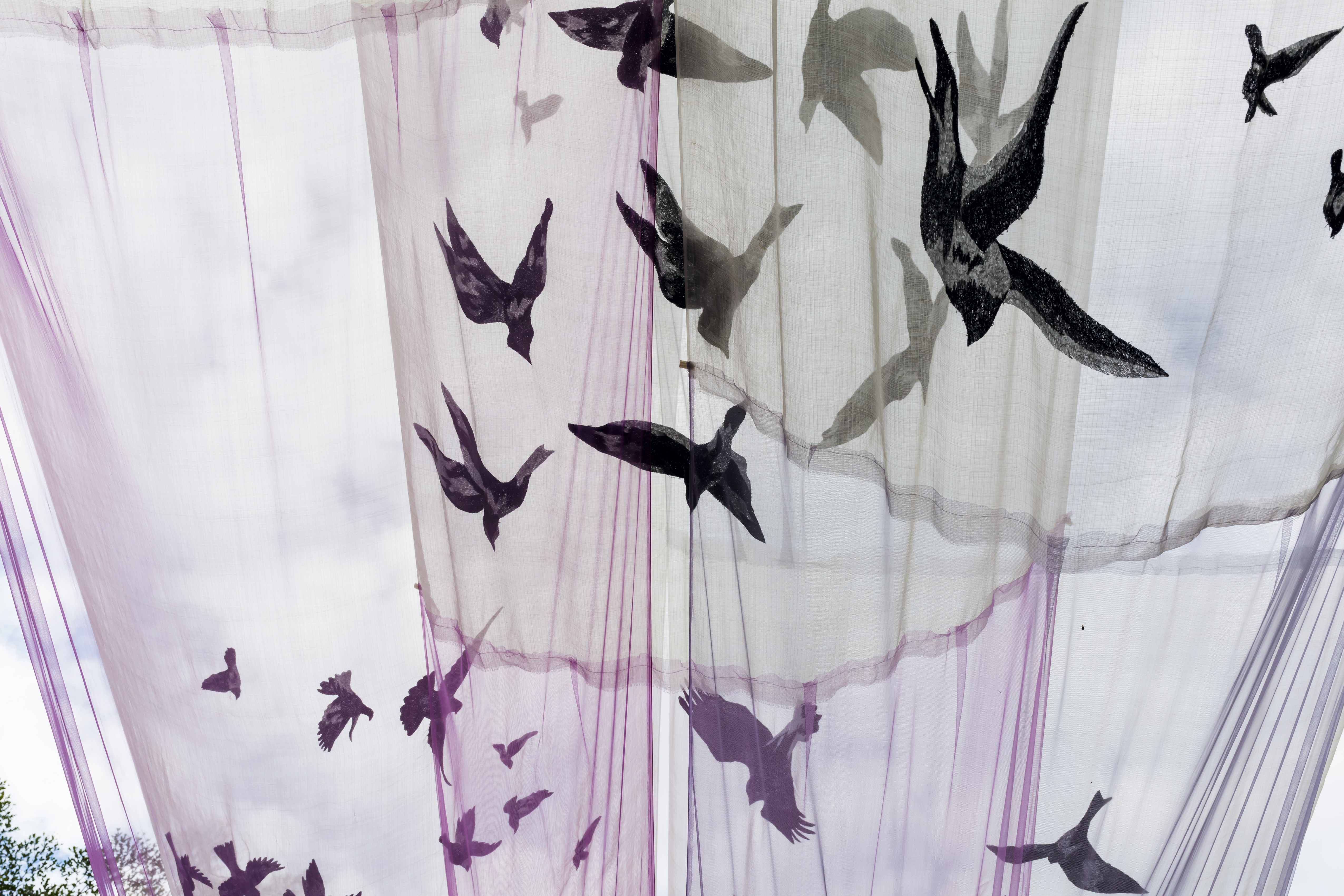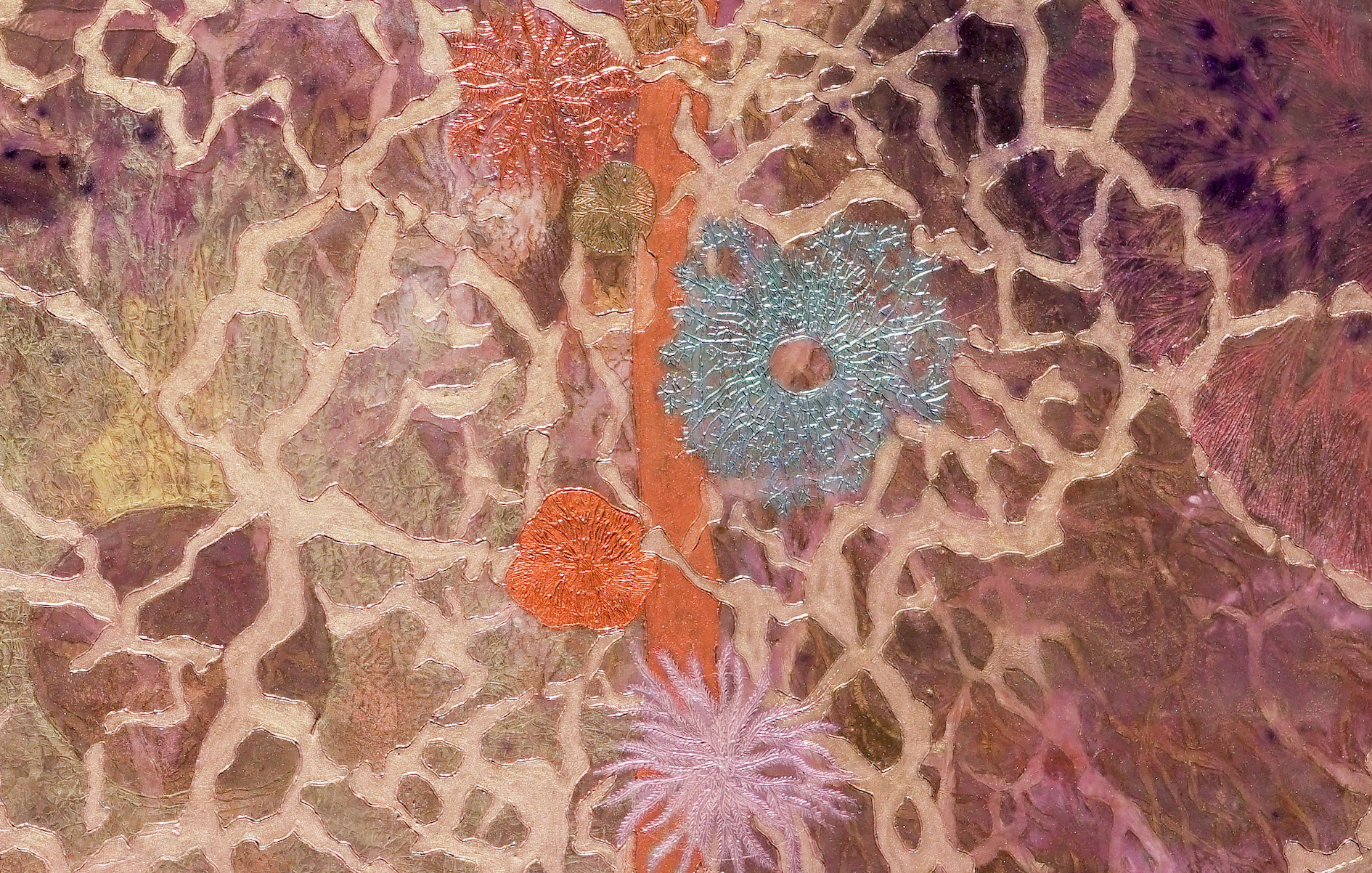On the afternoon of 19 November 2022, Mizuma Gallery hosted an Artist Talk in conjunction with our ongoing exhibition “Here We Are On Earth“, featuring Filipino artist, Geraldine Javier, moderated by Tony Godfrey.
___________

Exhibition view of ‘Here We Are On Earth’ at Mizuma Gallery Singapore, 2022. Photography by Adikara Batubara, courtesy of Mizuma Gallery.
Tony Godfrey: Okay, Good Afternoon. I am Tony Godfrey —
Geraldine Javier: I am Geraldine Javier.
Tony Godfrey: – and Geraldine has asked me to sit here and ask her a couple of questions to get her going. I know several of you were here at another gallery, about ten years or so ago, when Geraldine last showed here. In those ensuing ten years, probably one of the most important things in your life was leaving Manila and moving to the countryside. Is that correct?
Geraldine Javier: Yes, yes, of course. I made lots of changes in my works when I moved from Manila to the country because in Manila, it was a small studio and not much space, and you don’t really get to know the people living around you. So, when I moved from Manila, from being introspective, I became more aware of the people around me, I became more active in working with the community, and also, the studio practice has changed a lot.
Tony Godfrey: In what way do you work with the community?
Geraldine Javier: For me, when I moved to the province, I did not really know the people, so one way of knowing them is by getting them involved in the installation. In Manila, I only had a few girls working in the house, whom I also taught embroidery to. When I moved to the province, I expanded it – I dreamt of a more ambitious installation that would involve lots of mothers in the community. I also involved some of the men in the sculptural installations.
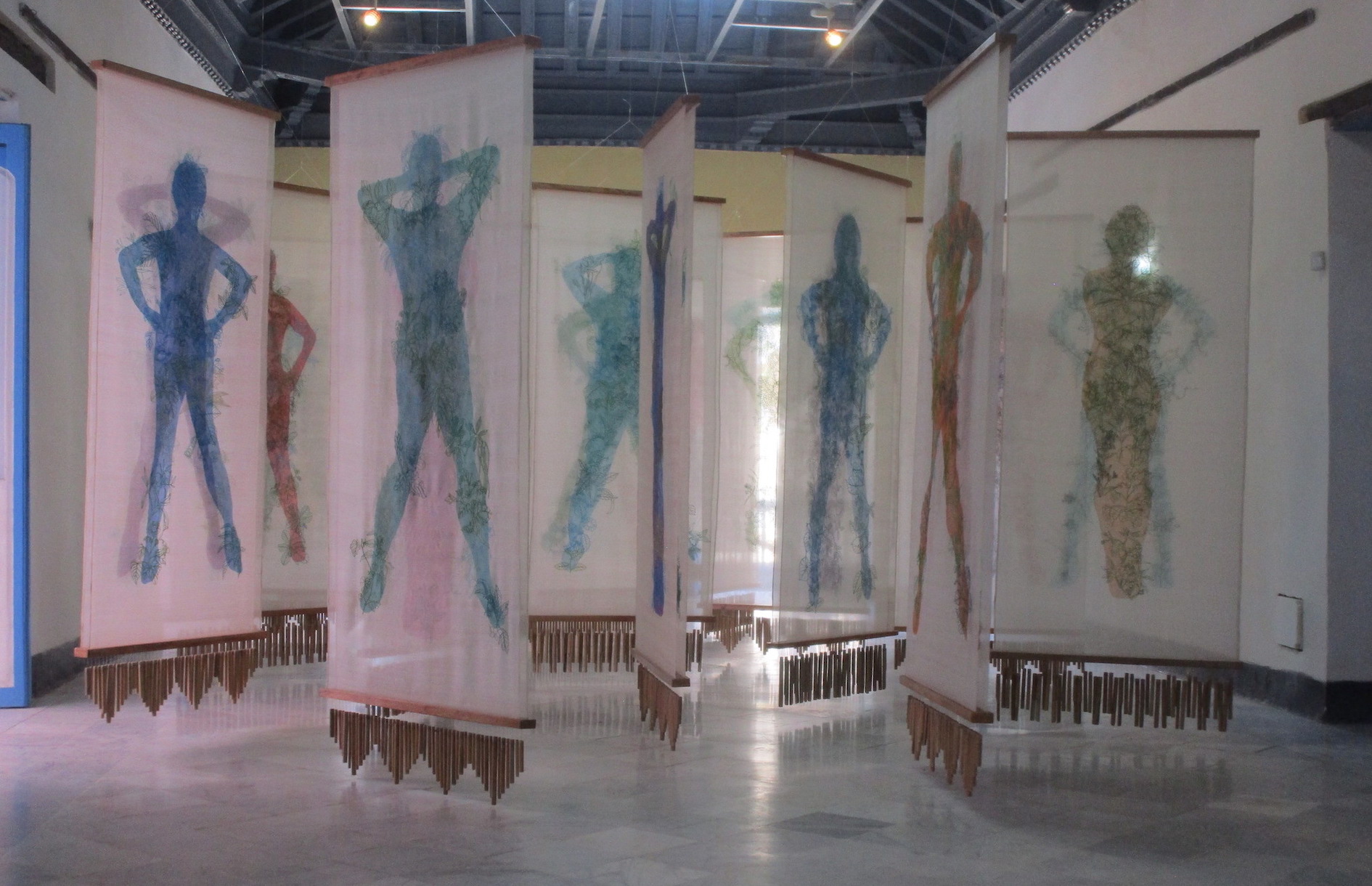
Spinning Women, 2018-19, acrylic on pineapple fibre, embroidery, wood, dimensions variable. Shown in Casa de Asia, 13th Havana Biennial, 12th April – 12th May 2019. © Geraldine Javier, courtesy of Tony Godfrey.
Tony Godfrey: You did a really large project for the Havana Biennial [“Spinning Women”], I think three years ago, where you had twenty-two life size hanging figures. How many people worked on that installation, doing embroidery and so on?
Geraldine Javier: The embroidery, approximately nineteen women including myself. For woodwork and so on, there were five men who did the chimes and assembled the pieces. The other twenty-two women involved were the studies of the installation. I went around, seeing them, getting to know them, and I worked constantly with the embroiderers. It’s an informal studio practice, because we also had Christmas parties, get-together with the people and their children.
Tony Godfrey: How many people worked on this exhibition – are there fifteen?
Geraldine Javier: Yeah, around fifteen. It’s always been like that. For the embroideries and the floor installation. But for the paintings, they are all done by me, entirely.
Tony Godfrey: Once you are in your studio, you are on your own? Unless it’s an installation.
Geraldine Javier: Yes. It’s my quiet time.
Tony Godfrey: The other thing that is important to say is, when you were in Manila, your garden was about the size of this bench we are sitting on (laughs). It consisted of a couple of balconies, and a very small pocket. You’ve now got two and half hectares of ground with trees and plants. How has that changed your life?
Geraldine Javier: As I said before, I was thinking more internally in Manila, confined to a small space. So, it was about death, about being miserable and bitter. The perspective changed when I moved to the province. It’s like being aware of your environment, it has expanded and brought more positivity.
Tony Godfrey: I seem to talk about the garden because in a way this exhibition is a change from a lot of the works you have made in the last five to six years. If I think about your last exhibition in Artinformal, Manila which was a year ago, it was based on five gardeners. Four famous people who made gardens as art: Monet, Frida Kahlo, Gertrude Jekyll who is this great English garden designer, and Derek Jarman the filmmaker who made a famous garden on the seashore; and your garden was the fifth. Your interest was very much in the notion of artists who make gardens, our relationship to nature. What do we see here, this work with images of star systems and planetary systems?
Geraldine Javier: OK, I’m going to give you a long background of the show, bear with me please (laughs)
Tony Godfrey: (laughs) Go on –
Geraldine Javier: First of all, I’m really glad to be here, to be back in Singapore. I became more appreciative of what Singapore now represents for us Filipinos, that is order and direction which we don’t have right now, we are on autopilot. The pandemic had been really hard on us Filipinos, we have sort of been brutalised by the government, in their dealings with it, and how they dealt with us. But the pandemic is not all that bad for an artist like me, and some of the artists who were lucky to live in the countryside at that time. It was a time of peace and calm, except for when there were surges [in the number of Covid-19 cases]. We were brutalised but we had this kind of environment where we also grew as a person and as part of a community. At that time, we felt that we were a part of a larger thing, rather than just part of our studio. We initiated efforts to help our community, that’s why we were able to focus our anxieties towards the people outside, so it wasn’t that bad for us.
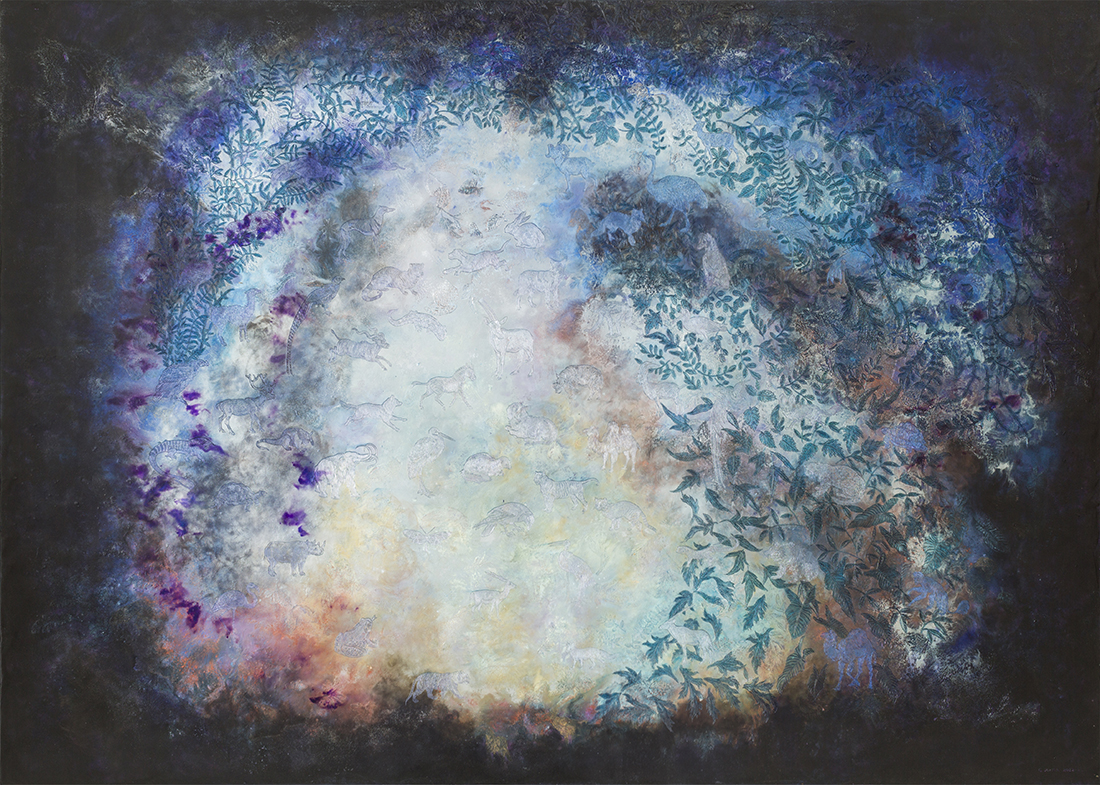
The Oort Cloud, 2021, acrylic, powdered pigment, encaustic on canvas, 152.5 × 212 cm (5 × 7 ft). © Geraldine Javier, photography by At Maculangan of 123 Pioneer Studios, courtesy of the artist and Mizuma Gallery.
The works in the last solo show, “Five Gardens”, had a lot of optimism. I was able to really work on those pieces because I really took my time. It made me appreciate the gift of time – there was no deadline. I was just happy to be an artist at that moment, given this gift of time, to work on those pieces. This continued onto the first painting I made, “The Oort Cloud”, there was still some positivism.
Another background to this painting was that during the pandemic, I read a lot of books, listened to Audible. One of the many books I read was the novels by Cixin Liu, an award-winning sci-fi Chinese novelist. You should read all of them (laughs), they are really good. He’s very creative, imaginative. I wanted to be a part of the world he created in his books, through my paintings. But with a different mindset. I know that might look like bringing all the living things outside of earth, looking for a viable place to live. But I know it can be done again on earth. We can remake things, we can reset things after the pandemic, people have a different mindset now. I was really expecting and hoping for a different mindset, for example, for myself, I don’t like to shop anymore (laughs).
So, there was a pause. After that, I made this painting [“Dark Matter”], but originally it did not look like this – it was a much lighter painting. I thought I was finished with it. And then I started becoming very involved in the campaign during the last election. I was creating programmes for the community, making banners, making gimmicks to help in the campaign – there was so much enthusiasm, we thought we could change things. We were hopeful and at the same time, scared. But more hopeful.
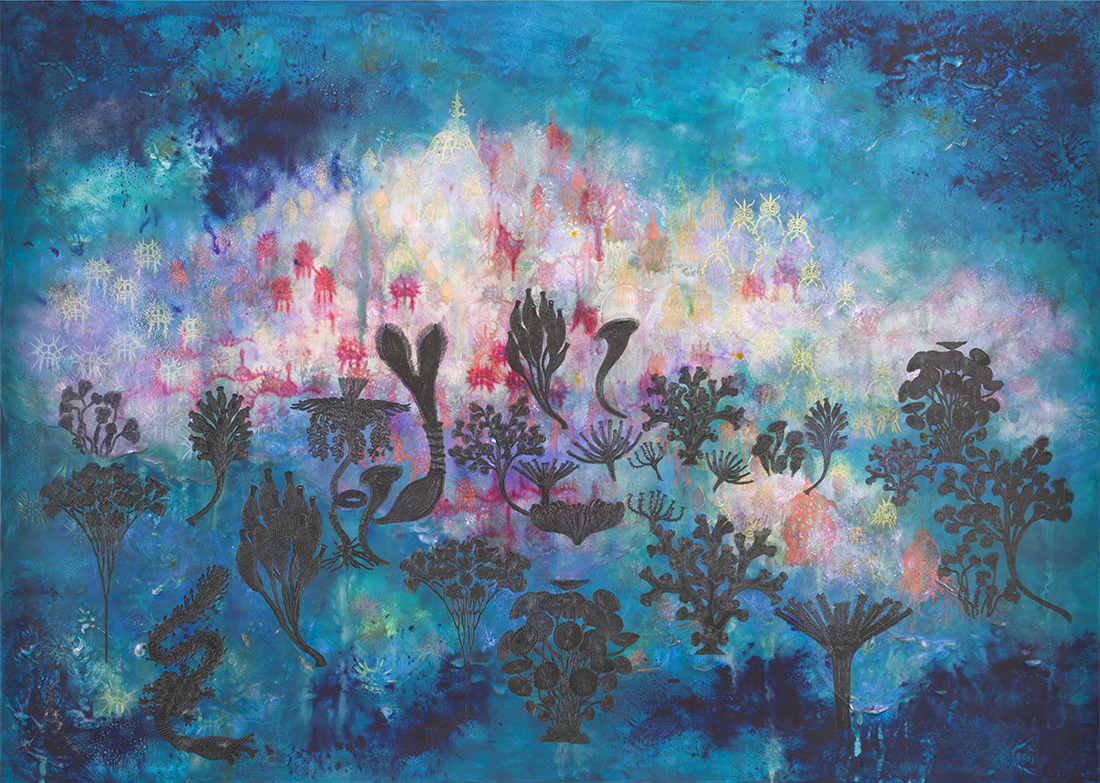
Dark Matter, 2022, powdered pigment, encaustic on canvas, 152.5 × 212 cm (5 × 7 ft). © Geraldine Javier, photography by At Maculangan of 123 Pioneer Studios, courtesy of the artist and Mizuma Gallery.
An hour after the election, things went crashing. It was hard to explain. There was collective anger and depression. Not just for a day, not just for a week. It went on for months. For the artists, a lot of us stopped working. We did not know where to start, what subject matter to explore, because it seemed hopeless. We couldn’t understand a lot of things. It was a very confusing time for a lot of us.
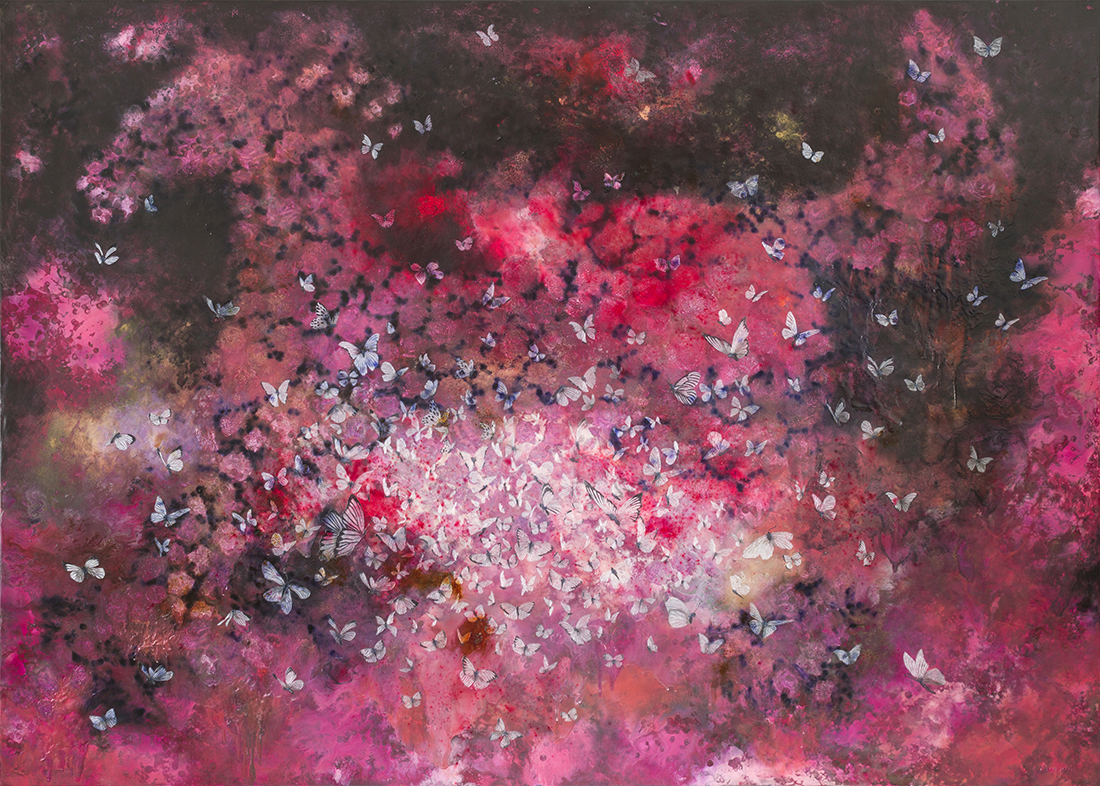
Cassiopeia A, 2022, powdered pigment, encaustic on canvas, 152.5 × 212 cm (5 × 7 ft). © Geraldine Javier, photography by At Maculangan of 123 Pioneer Studios, courtesy of the artist and Mizuma Gallery.
But the deadline was looming. I had to meet my deadline. I always managed to keep my deadline, so after two weeks of not working, I started on this piece [“Cassiopeia A”]. I said, I had to get this out of my system – the anger. Does it look angry? (Laughs) No?
You can see underneath there are engraving of roses. The roses were used as a symbol in one of the political campaigns [of Leni Robredo]. At that time, we felt the campaign was like a galloping horse, which then dissipated.
I’m glad I made this piece, because after that I was able to move on again, and I went back to the second painting [“The Dark Matter”], and it became darker.
Tony Godfrey: It was much more poppy, and bright, and sparkly originally.
Geraldine Javier: Yes, before, it was like a mysterious underwater scene.
Tony Godfrey: One thing to add, each of these paintings took a very long time to make. The more you look, the more you realise there are lots of buried layers there. You do work, and then you cover them with encaustic, and start working again on top of that.
Audience: I’m not sure if I understand you correctly. You started on this painting [“Dark Matter”], and you were very emotional about your involvement in the campaign, so you did this [“Cassiopeia A”], then you came back to this work [“Dark Matter”]. In the first attempt of this work [“Dark Matter”], what was your composition?
Geraldine Javier: You will not see this [gestures to the dark figures on the foreground]. The underneath is light, very light. It’s like when you go snorkelling, you see these colourful corals. But these are not corals. They are drawings of nature, scientific illustrations. I wish I had taken a photo [of the earlier composition], sometimes I forget to. I should be doing that, because it really changes.
Tony Godfrey: Actually, I took a photo of it when it was on the easel in your studio before it became black.
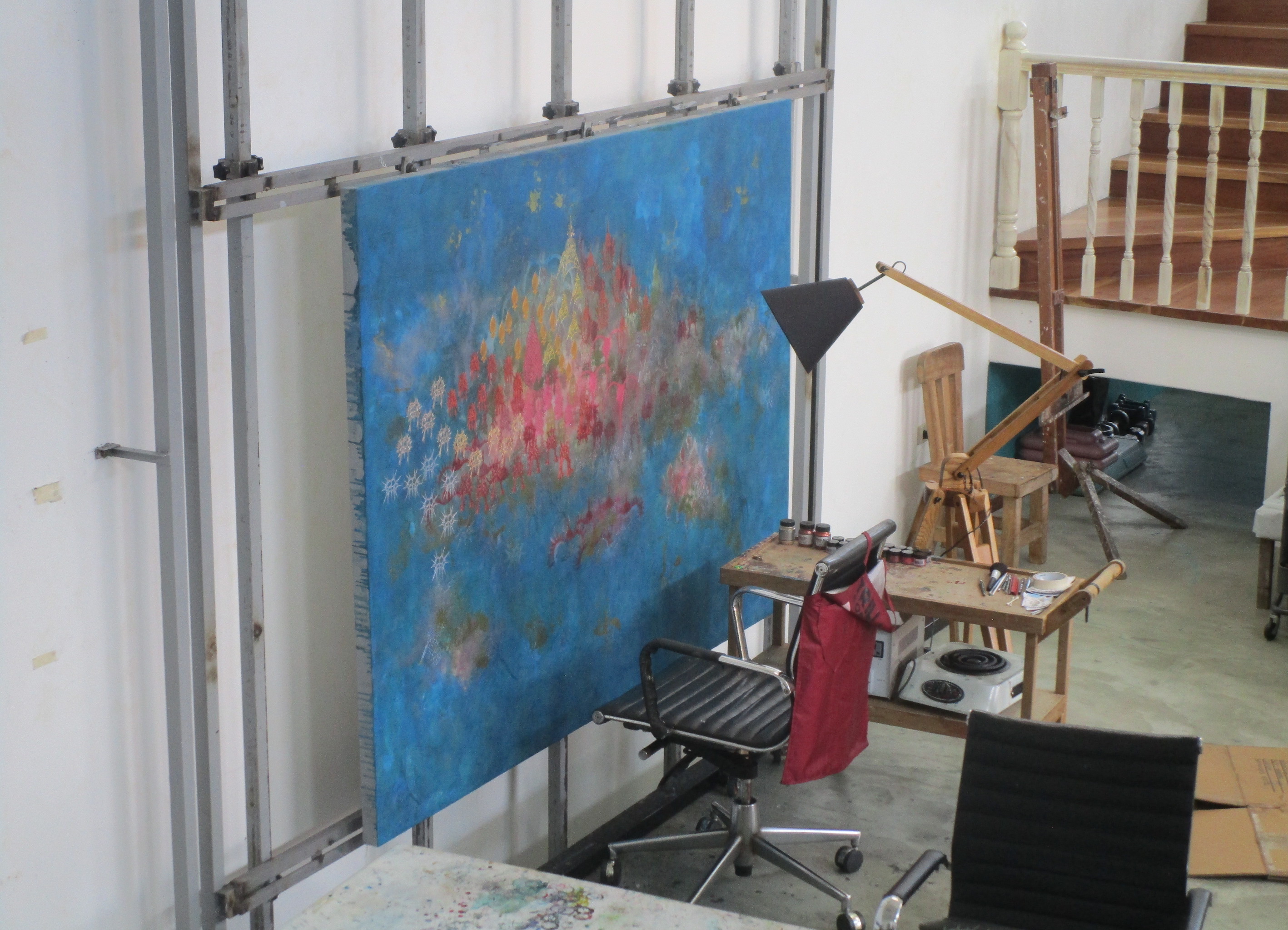
Work-in-progress at Geraldine Javier’s studio, photograph taken by Tony Godfrey. Image courtesy of Tony Godfrey.
Geraldine Javier: I worked on most of these paintings for about two months. I would apply layers and layers of melted beeswax and resin, torch them, draw on them, apply pigments, create engravings, apply something that would protect the engravings, knowing that they could be damaged in the next application. It has been a part of my process, burying both the successful attempts and even the failures. For me, that’s okay, that’s part of the process that enriches the work, even though you can’t see everything that is hidden inside.
Audience: You started finishing this after the election?
Geraldine Javier: Yes.
Audience: So, it was more positive before the election? And then more sad after?
Geraldine Javier: Yes (laughs)
Audience: Thank you.
Geraldine Javier: We were also working on this [“The Golden Cell (Endurance Test – The Fuck Us Years)”], it was just a few blocks that I was not sure of where it was going. After the election, boom! We had to really do this, my heart is in this, we had to get this out of us, we had to do something.
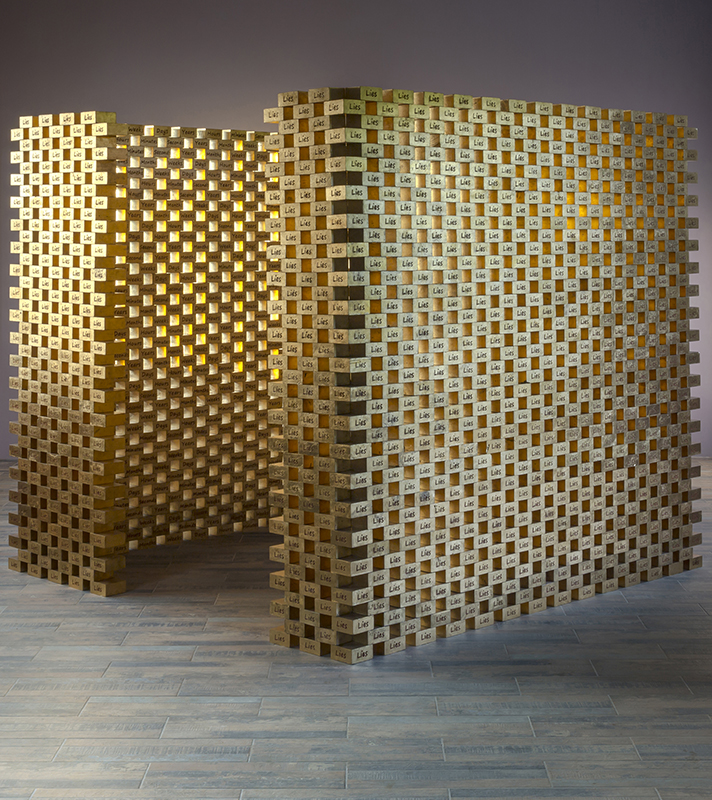
The Golden Cell (Endurance Test – The Fuck Us Years), 2022, wood, paint, imitation gold leaf, 183 × 183 × 173 cm (6 × 6 × 5.7 ft), (set of 1,860 pcs, 4.5 × 9.5 × 9.5 cm each). © Geraldine Javier, photography by At Maculangan of 123 Pioneer Studios, courtesy of the artist and Mizuma Gallery.
Tony Godfrey: Can I just point out that you became so involved in the election against the… um –
Geraldine Javier: Who should not be named! (laughs)
Tony Godfrey: – that you would spend every evening on the internet.
Geraldine Javier: Oh yeah, being a bully? (laughs) No, I’m not a bully. Arguing. Trying to be an online warrior.
Tony Godfrey: This was the first time that you ever got involved in politics.
Geraldine Javier: Yes, I actually have never voted in the presidential election for a long, long time, because I knew it was going to be the same. But that’s wrong. Even though you know you are going to lose, you need to always fight for what you believe in.
Would you like me to talk about this piece? The title is “The Golden Cell (Endurance Test –The Fuck Us Years)”. It’s made of wood blocks repurposed from crates that were dumped in our province –
Tony Godfrey: Or from pallets, Singapore’s full of them, it’s how they move stuff around.
Geraldine Javier: I’ve used some of them in my previous installations. I like working with what’s already in the environment, so most of the materials in my installations are organic materials. We created wood blocks and these were hand engraved by my staff and other men from the community. It’s all manual hand engraving – it’s a long process.
On the inside is about time, from seconds to years. When you go inside, it’s contemplative. On the outside, the word ‘Lies’ is written.
Going back, there was a lot of disinformation that was the main culprit in defeating the Filipino people as a whole, because we don’t really know if we were cheated, or if there’s just too many people who converted to the lies. This piece is not just about the critique on the Marcoses – it can be, because of the lies about the Tallano gold being distributed to the Filipinos if he wins the elections. Of course, when you are in a miserable state, you would have the tendency to believe in something good happening to you, even the impossible. But for me, it’s a critique on myself, and how we have come to this: how come we have not acted more vigorously? How come we are in our houses, in our comfortable houses? How come we are not on the streets, protesting? So – I don’t know the answers to those questions.
Tony Godfrey: It’s not just about the last Filipino election, this was also – you and I were both totally entranced by the Trump experience in 2016 and 2020. Before that, there was Brexit, the referendum. Campaigns for those raised a phenomenal amount of disinformation, and in the case of Trump or Brexit, the interference from foreign powers. This is a global statement, it’s not particular to the Philippines elections in 2022.
Geraldine Javier: Yes, it’s not. But we had a chance.
Tony Godfrey:Why, inside, does it say ‘years, months, weeks, days, hours, seconds’?
Geraldine Javier: Because we don’t know when it’s going to end. We’re not really sure about our future.
Tony Godfrey: And when you say it’s a cell, is it a cell as in a prison or as a monastery where a monk or nun goes to contemplate?
Geraldine Javier: Oh, it’s a self-made prison, Tony. There’s a big middle class in the Philippines, and we’re comfortable. I think if we really want a true revolution, it has to come from the lower class, from the working class, together with the middle class of course. But we’re comfortable, we can live on autopilot. That’s the sad part.
Tony Godfrey: Surrounded, in a way where you’re not in Singapore, by people living in dire poverty, with very few possibilities of improving their lives.
Geraldine Javier: Yes, I think one thing wrong in the campaign was that they did not really mention the problem of inequality. Everyone avoided that word.
Audience: I’m very tempted to — I’m sorry to say that I found this quite optimistic, because I just want to pull one of those blocks out, and the whole thing comes tumbling down, and therefore, that would be the start of –
Tony Godfrey: It won’t work, they’re held together by steel rods (laughs)
Geraldine Javier: (laughs) I know, right. Just something, just a little something that will –
Audience: – get traction, and bring the whole thing down.
Tony Godfrey: Like topple blocks.
Audience: The Danish invented these wooden blocks, they’re all exactly the same weight so it’s balanced, and you can make these amazing structures and then you pull one then it all goes –
Geraldine Javier: – comes crashing, yeah. I don’t want to try that and injure anyone (laughs)
Audience: Yeah, they would be very angry because they spent a lot of time doing this (laughs)

Broadcast From The Sky, 2022, silk organza and piña cocoon fabrics, thread, dimensions variable, fabric width 114.5 cm (45 in) × total length 5360 cm (175.85 ft). © Geraldine Javier, photography by At Maculangan of 123 Pioneer Studios, courtesy of the artist and Mizuma Gallery.
Geraldine Javier: And the embroidery [“Broadcast From The Sky”]– this is something really nice to look at, especially when you are inside [the “The Golden Cell”]. It reminds you of what should be. It’s like freedom, just being free and simple.
Tony Godfrey: With all these birds, they are generic birds, they are not specific –
Geraldine Javier: No, no –
Tony Godfrey: You are not going to find a kingfisher, or a swallow, or anything specific? Well you probably could. These are sort of like all-purpose birds, aren’t they?
Geraldine Javier: Yeah, we started with just the silhouettes. Sometimes I like the girls to – I mean, I don’t want them to do repetitive things. I told them, you have to render these birds according to your imagination, according to how you see the birds around you. So, they started with black and white at first, and then I left it to them to make their own rendering, shading, using their thread, and they did a fantastic job.
Tony Godfrey: And why did you introduce these areas of colour?
Geraldine Javier: Colour, I just wanted to create something – colour, I need colour (laughs)
Audience: Why birds instead of your signature butterflies?
Geraldine Javier: Butterflies are not really a signature. I mean, it’s not a conscious decision when I use butterflies or other things. I’m drawn to butterflies because they are very colourful. I’ve used birds before, but dead birds, mostly. Now it’s different. I see flying insects, and flying everything in our new environment, because we adhere to our organic ways of maintaining a farm and garden. We are into regenerative practices, so you see a lot of them. They live inside our house (laughs)
Tony Godfrey: What about the fourth painting [“Here We Are On Earth”]?
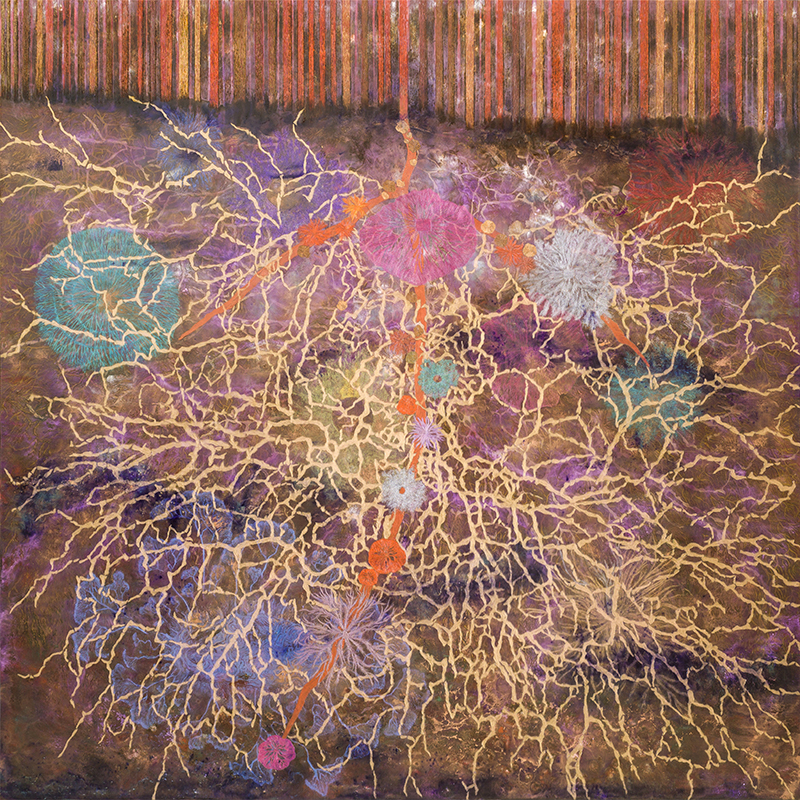
Here We Are On Earth, 2022, powdered pigment, encaustic on canvas, 183 × 183 cm (6 × 6 ft). © Geraldine Javier, photography by At Maculangan of 123 Pioneer Studios, courtesy of the artist and Mizuma Gallery.
Geraldine Javier: The fourth painting, it’s about coming back or coming down to earth. You cannot make changes if you are just dreaming and projecting yourself onto another universe. So, this is a Mycorrhizal network, a fungi network, and hidden underneath are also networks. I want to explore more on that – these networks of things in nature, supporting each other, helping each other to grow, and recognising that this does not only exist in the plant kingdom, but also in the microscopic analysis of the animal kingdom, insects, people, everywhere. Even in the cosmos, they also have this kind of configuration. So, we are all one. This last painting is also the start of a new series of works for my next show.
Tony Godfrey: In a way, originally you were planning more than three paintings like this, weren’t you?
Geraldine Javier: Umm, planned, but cannot be executed (laughs). I can only do five to six paintings in a year.
Tony Godfrey: One thing that has changed since you showed here last, is that you started making small paintings. For a long time, you always said that you’d never make small paintings. Last year, you suddenly produced three or four as an experiment, and they worked. So, what happened?
Geraldine Javier: What happened? For me, it was more daunting to create small pieces. How can you put a lot of things onto a very small canvas? It has always been a challenge. Then I did those three, and I thought, why not try to explore that? Bringing the cosmos onto a small canvas. I also wanted to create a sort of explosion, like, stars. Somehow it works.
Tony Godfrey: Years and years back, you did a sort of multi-part painting which you called “Nocturns”. These are night paintings, aren’t they? And traditionally, Nocturns, as in musicals, often rather are dreamy, poetic pieces. Is that how you see these small paintings?
Geraldine Javier: How do you see these small paintings? (laughs). I’ll ask you, Tony, how do you see these paintings?

Indistinct Chatter From Below (A), 2022, powdered pigment, encaustic on canvas, set of 3 panels, 56 × 61 cm (22 × 24 in) each. © Geraldine Javier, photography by At Maculangan of 123 Pioneer Studios, courtesy of the artist and Mizuma Gallery.
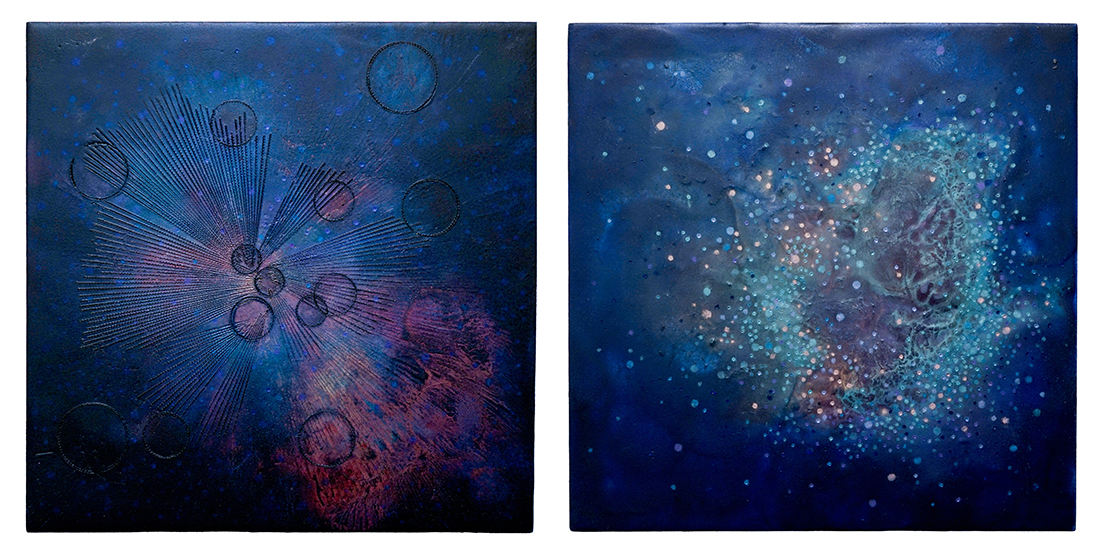
Indistinct Chatter From Below (B), 2022, powdered pigment, encaustic on canvas, set of 2 panels, 35.6 × 35.6 cm (14 × 14 in) each. © Geraldine Javier, photography by Mizuma Gallery, courtesy of the artist and Mizuma Gallery.
Tony Godfrey: How do I see them…I like them very much. I think one thing that is interesting with the big paintings, you started off vaguely trying to create something like the star systems you see in the big Hubble telescope, but then so much else happens in the big paintings that it starts to disappear. So, this one, you wouldn’t even realise that they began as a star system painting. But this — the star system stays here, they keep that. If you’d like, perhaps, they stay in the sky, the way the others don’t, and they do seem nocturnal.
Geraldine Javier: I think I became calmer too, because I did this last, after those paintings, and I sort of calmed down. As I did the star one by one, it was a period of calm.
Tony Godfrey: So, there’s no splatters, each star goes on – with a decision?
Geraldine Javier: Yes.
Tony Godfrey: Right. I’m sure after ten years, some of you [audience] have got questions.
Audience: Questions on the material – you used acrylic, you used pigment, and you used encaustic, which is the wax with pigments. Do you have any order, and what attracts you to the combination?
Geraldine Javier: In my first work in the ‘Five Gardens’ show, I did not use pigment. I used acrylic, and some metallic acrylic. For this show, I wanted to try the pigments, especially the metallic ones, because I was going to do the cosmos. It would be difficult to create that kind of atmosphere in acrylic, that’s why I used the pigments. But when I applied it, I used a heat gun to make the pigment melt and be absorbed with the wax. When I was done with the entire process, I applied an acrylic medium to make the encaustic more durable and harder. I think I’m the only – maybe, there’s just one or two of us working with encaustic.
Audience: What attracted you to encaustic?
Geraldine Javier: The smell (laughs). No, it can be bad for your lungs. You need to have lots of open space, lots of ventilations –
Tony Godfrey: And a mask.
Geraldine Javier: And a mask, yeah. But it’s very unpredictable, that’s why I like it. You’ll never get the same reaction, you’ll never get the same look. It’s always going to be different. So how you mix the paints and all those techniques will dictate what the final look will be. I can never have a final study, maybe just an idea that is very much open to changes.
Audience: And your engravings, it looks almost like it’s embroidered onto the painting.
Geraldine Javier: Because I used a needle.
Audience: It looks like it’s coming out, so you get to see the needle embroidery.
Geraldine Javier: I didn’t actually know it would look like that. I was surprised with how it looked after engraving using a needle. It’s a meditative practice – I like the part when I did the engraving, that was one of the best parts. But sometimes when I apply the encaustic, it can be heart-breaking to see that the first layer is ruined and hidden. One of the girls would say, “Ate G, stop, what are you doing? You are destroying your painting.”
Audience: And it’s all on canvas?
Geraldine Javier: Yes, canvas –
Tony Godfrey: And wood, you have wood behind, because you like working on a firm surface.
Audience: So, in your previous works of gardens, it’s about optimism. If you were to describe this body of work, how would you describe it, in context to that? Because in each, you show darkness, but there’s also light.
Geraldine Javier: Oh, what a difficult question. I think there’s gravity to the works, especially the paintings that I couldn’t – maybe that’s what I’m feeling right now. There’s some kind of gravity, not really tiredness, but something that you want to get out of. That’s why there’s also some light emanating from it, because you don’t want to just be dark, dark, dark, dark, right? There’s some kind of a tunnel that you can see in all of them, in the middle –
Audience: Yes, there’s hope.
Geraldine Javier: Yes, I like to strike a balance, I think, almost every time. I always want to balance it out.
Tony Godfrey: Yes, there’s always a fight between dark and light (laughs).
Audience: Is this a series that you are going to continue? I’m just thinking of what you said about the politics in your country and Trump. He didn’t win the last election, so that was kind of a blink of hope, and then he’s running again. With Marcos, on politics and what he did to be upset about in the last election results. Just to continue that line of thought, there was hope, then this heaviness, this despair, and then the blacks all come in and there’s a bit of hope here – it’s kind of like a yo-yo right. And that’s really hard, I think, especially if you’re very invested in it. Are you thinking that this might be something that you would continue?
Geraldine Javier: In a different way, yes, in a different form. A lot of the themes in my exhibitions are like phases in my life. I cannot work with something that I cannot really relate to. It is going to be a different treatment but something more transformative. Politics is not the real world we are facing, I’ve realised. It’s the climate crisis. It’s something that I can do something about in my little world, that can also be an inspiration to my future works.
Audience: When you look back on your practice, you have had a lot of years of practice. These ebbs and flows that you experience, do you see a pattern? Do you see whether, “Oh I recognise that this is me, it’s my essence”? Can you kind of tell?
Geraldine Javier: I think so, because I’m a very sensitive person. I cannot shield myself from the environment, from what’s happening. I get so upset, so emotionally engaged. I find it difficult to detach myself from all these things. It’s also part of my–(laughs), the problem is that I always listen to the news, I always want to know what’s happening in the world. During the pandemic, I listen to the updates, not just on what’s happening in the Philippines, I want to know what’s happening in Singapore, I want to know what’s happening in Korea, in Japan, in Europe, in the US, even in politics, I want to know how will this affect us. Even though everyone who’s been to our place thinks it is heaven and idyllic, it’s not. It has lots of problems. Aside from working in the studio, I’m also running a farm. I’m dealing with lots of people, I also deal with their problems, and their problems become my problems.
Audience: This is like me watching K-Drama (laughs)
Geraldine Javier: Yeah (laughs), you don’t want to know!
Audience: So, how do you decompress? You’re so engaged with everything and you express it in your art, which is also at a very high level. At some point, you’ve got to self-care, you’ve got to calm down, how do you do that? What do you do?
Tony Godfrey: A glass of wine in the evening.
Geraldine Javier: (laughs) A glass of wine in the evening, correct. And we have dogs, we have lots of dogs. One is missing now. We have eleven dogs, two cats. I like feeding the rabbits, the chickens. I like being able to provide. I like being involved in our organic farm, I see the day-to-day running of it. I’m very much involved in that, just walking back and forth.
Tony Godfrey: A very basic change in your life, in Manila, you’d start painting at 8 o’clock and stop painting at 8 o’clock. Whereas now you go to the studio, but then maybe you’d wander off, have a walk in the garden, so you’re back and forth, in a totally different way. There’s a constant interchange in your life, between the garden and the studio.
Geraldine Javier: Yes, it is, that’s the break. And Netflix (laughs)
Audience: What are you watching?
Geraldine Javier: We’ve finished seven episodes of the ‘Last Madame’, it’s about a brothel in Singapore.
Tony Godfrey: What has been your favourite Netflix series recently?
Geraldine Javier: Wow, so many… we’ve watched so many. But the ‘Mind Hunter’ was the best for me.
Tony Godfrey: When we rented them on DVD, ‘The Bridge’ was a big favourite. ‘Game of Thrones’, did you watch that?
Geraldine Javier: Yeah, of course Tony!
Tony Godfrey: Has anyone got questions?
Audience: Those blocks behind, they are not glued right? They’re just stacked on each other?
Geraldine Javier: No, there are holes and there are stainless steel pegs. We wanted to make sure that if anyone bumps into it, it’s going to be stable.
Tony Godfrey: It took a very long time to put together. About two days, and between three and five people working on it.
Geraldine Javier: By the way, feel free to sit on the stool [gestures to “The Golden Cell (Endurance Test –The Fuck Us Years)”]
Tony Godfrey: If no one else has got a question, can I ask, what are you going to do next? When is your next show?
Geraldine Javier: My next show will be next year, another solo show, at Silverlens Manila. Before I finished these works, I said to myself, I’m going to take a break for two months, December and January. I’m not going to do anything. But guess what, it’s November, we’re already starting to experiment with fabrics for the next show, and I’m very, very excited about it. It’s just a nice dream to have a vacation for December and January. But if you really like what you’re doing, you’re excited, it’s nothing, it’s not a work.
Tony Godfrey: After the show at Silverlens, the year after, it is…?
Geraldine Javier: Maybe Korea, a show in Korea.
Audience: Were you thinking of the aircon moving gently at your installation when you built it?
Tony Godfrey: We always knew it was there.
Geraldine Javier: Yeah, and there was an installation, the one from Havana Biennial, which I really needed the air to move the pieces, because it has bamboo chimes.
Tony Godfrey: The only trouble there was that we were relying on the wind that came through the windows, which normally was very gentle and then there was a storm and it was chaos. It’s difficult. But this one is steady, so it’s not a problem.
Geraldine Javier: We had to take a hi-res photo of this embroidery in my studio and we couldn’t fit them in, they were too long and we didn’t have the structures to attach them to the ceiling. So, what we did was that we took them out, and used lots of the bamboo that we had to lift it up. They are more beautiful outdoors, especially with a gentle breeze.
Tony Godfrey: Okay –
Geraldine Javier: Okay, thank you so much.
Audience: (applause)
Geraldine Javier: Thank you, I hope that this is worth your time.
––––––––––––
About the Artist
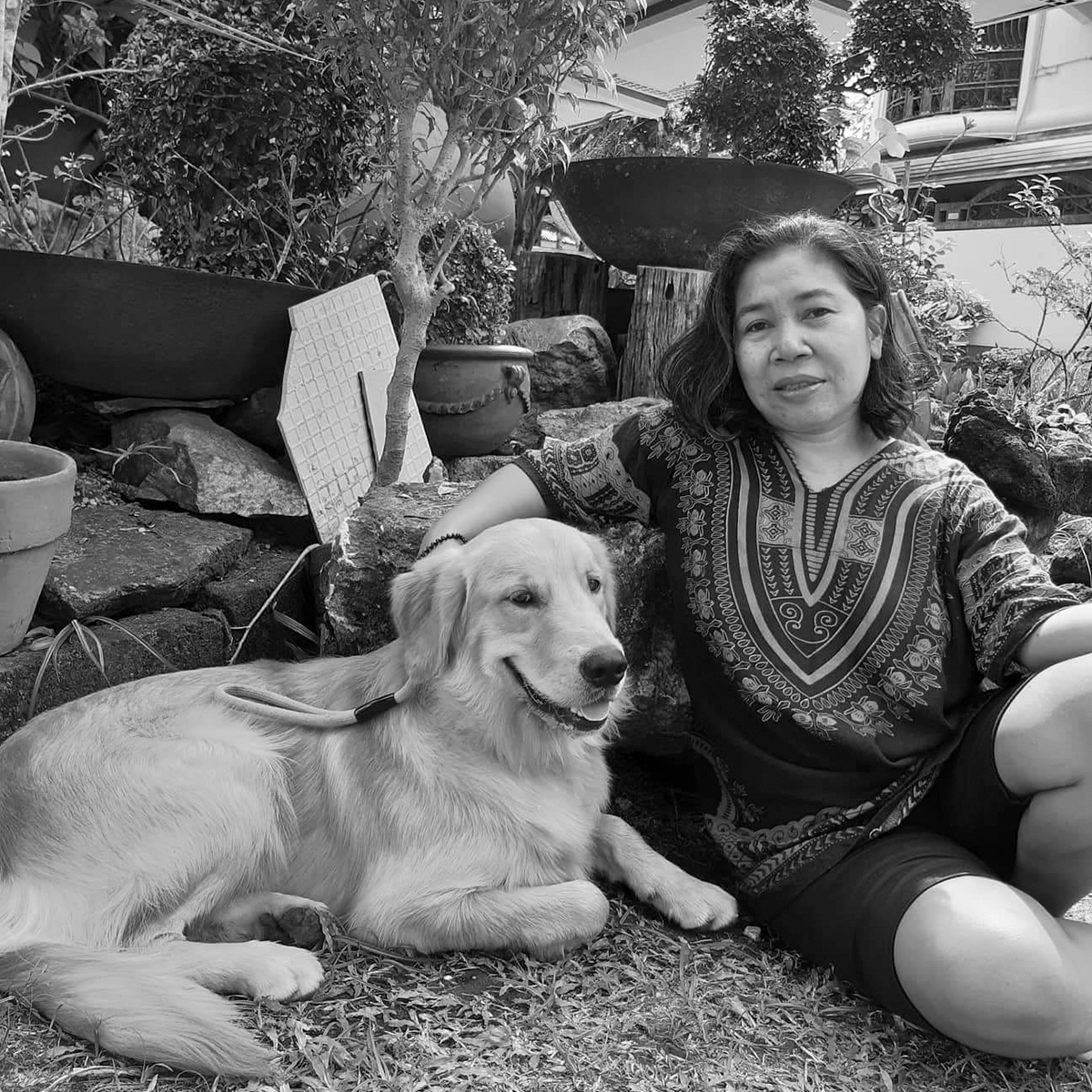 Geraldine Javier (b. 1970 in Makati City, Philippines) was brought up in the Philippines in the provincial town of Candelaria. In 1987, she moved to Manila to study nursing at the University of the Philippines, graduating in 1991, placed 8th in the annual Nursing Board Exam. In 1993, she returned to the Fine Arts Department of the same university, leaving in 1997 before graduating. In 1995, she had her first solo exhibition, and by 2019, she had had another 34 solo exhibitions in the Philippines, Malaysia, South Korea, Singapore, Germany, and China. From 1999 to 2003, she was a member of the Surrounded By Water collective and showed in their gallery in Angono and then Manila. She has remained connected with the collective, though they now exhibit together only occasionally. Much of her early work was in collage form, but it was with paintings that she established her reputation as an inventive artist. They were characterized by either melancholy or wit: death and childhood were frequent subject matters. By 2008, she was making fabric works with the paintings and combining them in installations. From then, her exhibitions would normally be a mixture of paintings, installations, and objects. Paintings would often have collaged elements, notably preserved beetles and butterflies. In 2013, she moved south from Manila to the countryside in the district of Batangas. A committed gardener, her work increasingly dealt with our relationship with nature. Also, much work, especially during the pandemic, was community-orientated. In 2019 she exhibited at the Havana Biennial. Around this time she began exploring two new forms of painting: palimpsestic and encaustic (with use of blowtorch). Geraldine Javier lives and works in Batangas, Philippines.
Geraldine Javier (b. 1970 in Makati City, Philippines) was brought up in the Philippines in the provincial town of Candelaria. In 1987, she moved to Manila to study nursing at the University of the Philippines, graduating in 1991, placed 8th in the annual Nursing Board Exam. In 1993, she returned to the Fine Arts Department of the same university, leaving in 1997 before graduating. In 1995, she had her first solo exhibition, and by 2019, she had had another 34 solo exhibitions in the Philippines, Malaysia, South Korea, Singapore, Germany, and China. From 1999 to 2003, she was a member of the Surrounded By Water collective and showed in their gallery in Angono and then Manila. She has remained connected with the collective, though they now exhibit together only occasionally. Much of her early work was in collage form, but it was with paintings that she established her reputation as an inventive artist. They were characterized by either melancholy or wit: death and childhood were frequent subject matters. By 2008, she was making fabric works with the paintings and combining them in installations. From then, her exhibitions would normally be a mixture of paintings, installations, and objects. Paintings would often have collaged elements, notably preserved beetles and butterflies. In 2013, she moved south from Manila to the countryside in the district of Batangas. A committed gardener, her work increasingly dealt with our relationship with nature. Also, much work, especially during the pandemic, was community-orientated. In 2019 she exhibited at the Havana Biennial. Around this time she began exploring two new forms of painting: palimpsestic and encaustic (with use of blowtorch). Geraldine Javier lives and works in Batangas, Philippines.
About the Moderator
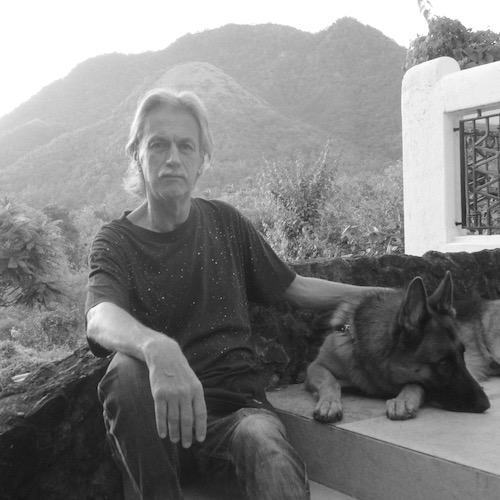 Tony Godfrey has been working in the contemporary art world since 1978 as, teacher, writer, and curator. His first book was New Image in Painting (Phaidon, 1986). His 1998 book, Conceptual Art – translated into six languages – was the first book to see Conceptual Art as a global phenomenon. His book Painting Today (Phaidon, 2009) attempted likewise to see painting as a worldwide phenomenon. It has been reprinted and translated into three languages. Tony Godfrey’s other books include Drawing Today: Draughtsmen in the Eighties (1991) and Contemporary Photography in Asia (2013). His two latest books, both published in 2020 are The Story of Contemporary Art (Thames and Hudson, and MIT Press), an attempt to understand contemporary art as a worldwide phenomenon, and Ding Yi (Lund Humphries), an attempt to give the local and global contexts for a Chinese Abstract artist. Having moved from London to Singapore and Asia in 2009, he now lives in the Philippines. In 2022, he launched his website arttalksea.com dedicated to interviews with artists from Southeast Asia (the most recent additions are Gerry Tan, Geraldine Javier, and Mawen Ong).
Tony Godfrey has been working in the contemporary art world since 1978 as, teacher, writer, and curator. His first book was New Image in Painting (Phaidon, 1986). His 1998 book, Conceptual Art – translated into six languages – was the first book to see Conceptual Art as a global phenomenon. His book Painting Today (Phaidon, 2009) attempted likewise to see painting as a worldwide phenomenon. It has been reprinted and translated into three languages. Tony Godfrey’s other books include Drawing Today: Draughtsmen in the Eighties (1991) and Contemporary Photography in Asia (2013). His two latest books, both published in 2020 are The Story of Contemporary Art (Thames and Hudson, and MIT Press), an attempt to understand contemporary art as a worldwide phenomenon, and Ding Yi (Lund Humphries), an attempt to give the local and global contexts for a Chinese Abstract artist. Having moved from London to Singapore and Asia in 2009, he now lives in the Philippines. In 2022, he launched his website arttalksea.com dedicated to interviews with artists from Southeast Asia (the most recent additions are Gerry Tan, Geraldine Javier, and Mawen Ong).




